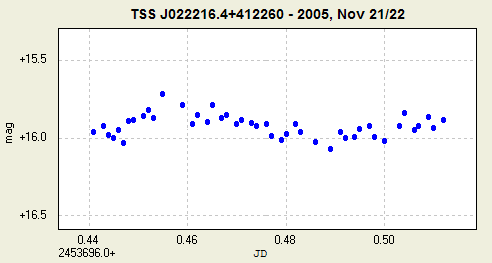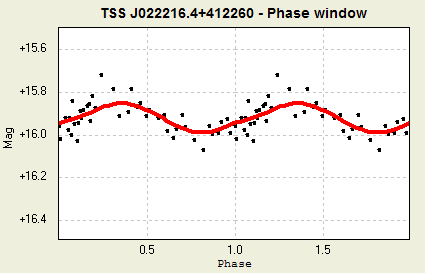 |
 |
 |
|
 |
| |
Detection
of superhumps in the new CV TSS J022216.4+412260
The Astronomer's Telegram #658, posted on Nov
17, 2005, announced the discovery by R. Quimby et
al. (Univ of Texas and The Nearby Supernova Factory)
of an optical transient, based on unfiltered CCD
images taken on November 16.1 UT (about 15.5 mag)
and November 17.1 (also about 15.5 mag), using the
0.45m ROTSE-IIIb telescope at the McDonald
Observatory. The object, named TSS
J022216.4+412260, is located at RA = 02h22m16.4s,
DEC = +41o22'59.9"
(J2000; uncertainty +/- 0.5").
It was not visible in ROTSE-IIIb data from November
15.1 UT (limiting mag about 16.5). A spectrum taken
by The Nearby Supernova Factory on November 18.6 UT,
with the Supernova
Integral Field Spectrograph on the
University of Hawaii 2.2-meter telescope,
showed it to be a dwarf nova in
outburst. The spectra revealed a blue continuum
with prominent H-alpha and HeII 4686
emission lines.
I started observations of TSS J022216.4+412260 on
Nov 21/22, 2005 at CBA Belgium Observatory, using a
0.35-m f/6.3 telescope and (unfiltered) ST-7XME
camera. The session lasted for 1.7 hours (had to be
interrupted due to clouds), and revealed a superhump
modulation.

Light curve of TSS
J022216.4+412260 obtained a CBA Belgium Observatory
on Nov 21/22, 2005
A period analysis using Peranso's
ANOVA method, yields a superhump period of 0.059
+/- 0.007 d, with an amplitude of 0.3 mag. The
object was around mag 15.9 during my
observations.


My findings are in good agreement with results
published by the Kyoto team, who independently
derived a similar superhump period, based on their
observations.
TSS J022216.4+412260 is amongst the shortest
superhumping dwarf novae presently known (e.g., Var
Vul 05 has a superhump period of 0.058 +/-
0.003 d).
|
|
|
 |
|
 |
|
|
 |
Copyright © 2005 - Tonny Vanmunster.
|
 |
|
 |